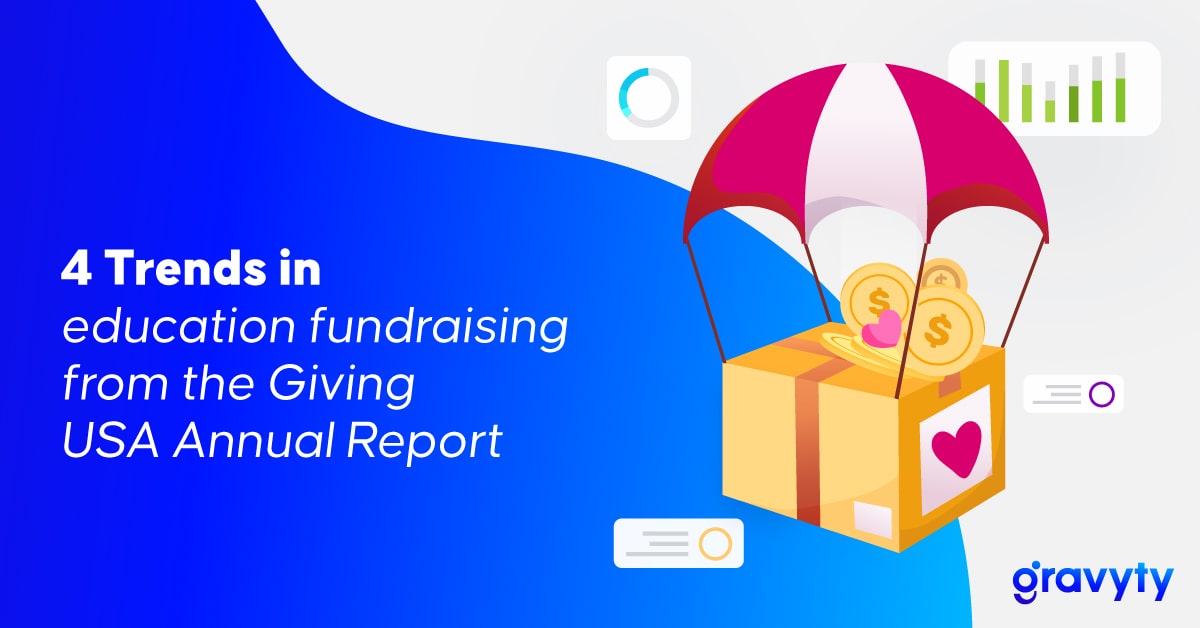4 trends in education fundraising from the Giving USA Annual Report

While the world adapts to a new normal following a global pandemic, a shift in the way we work leading to mass resignations, and now an economic recession, it can be overwhelming to consider achieving (and exceeding) fundraising goals. For K-12, independent schools and higher education institutions, fundraising and advancement is key to growing the academic, extracurricular and cultural programs for years to come. But are constituents still willing to give to institutions they care about in an economically challenging time?
This year, the Giving USA Foundation published their 67th annual issue of the Annual Report on Philanthropy for the Year 2021. Let’s explore four trends in education fundraising from this year’s Giving USA annual report.
1. Online giving is on the rise, both in higher education and K-12
While economic times are hard, Giving USA found that donations are still increasing. Giving to education increased 13.2% between 2019 and 2021, and 2021 was the strongest year of giving to education, just behind 2020. Playing a role in that increase is a boost in online giving. Fundraising software is making it easier for individuals to give quickly and securely online while being able to interact with the institutions and causes they are passionate about.
According to Blackbaud Institute, online giving to higher education institutions increased more than 13% this past year, while giving to K-12 increased 11.7%. Specifically, online giving to higher education organizations grew at a rate of 56.4% over the past three years. Universities and colleges should take advantage of the rise of online donations for upcoming Giving Days, annual giving campaigns and targeting major gifts donors.
2. Mega-donors have a big impact and want to see their dollars go to underserved student communities
According to the Giving USA report, mega-donors continue to play a major role in supporting education, particularly showing interest in how their gifts are put to use in historically underserved student communities. Foundations and corporations invested heavily in historically Black colleges and universities and diversity, equity and inclusion programs and initiatives. Major donors doling out millions of dollars care about social change and want to see their money put to use in positive ways. It’s important for schools to steward relationships with major donors and showcase all the good their money is doing to fund societal change for generations to come.
3. Donors are passionate about diversity, equity, inclusion and accessibility causes
Giving to programs championing DEI and accessibility is on the rise across higher education and K-12 institutions. According to Washburn & McGoldrick, 52% of chief advancement officers reported that DEI efforts were a top fundraising priority in 2021, a spike from 2020 when 42% noted it as a top priority.
Major gifts going to DEI initiatives support this trend. Western Michigan University received the largest-ever private gift to a public university in 2021, totaling $550 million. This generous gift will allow the university to provide more affordable education for underrepresented student groups. Philanthropist MacKenzie Scott made gifts totaling $2.73 billion in 2021, with most of the organizations serving communities that have been historically underfunded. Funding DEI efforts is proving to be hugely impactful both for educational institutions as well as donors who want to see their dollars going to an important cause for societal change.
4. Academic medicine, research and healthcare initiatives are driving education donations
After more than two years of life in a global pandemic, it’s no surprise healthcare and medicine are top of mind for many donors. While capital campaign gifts slowed down in 2020 due to funding for emergency support for students amidst the peak of the pandemic, capital campaign giving picked back up in 2021 with educational institutions reporting large gifts to medical schools and research centers.
For example, Phil and Penny Knight made a $500 million donation to the University of Oregon, which will be used toward the Advancement Science Center and support faculty positions in bioengineering and biomedical data science. Educational institutions should put a focus on the great work being done in areas of science and medical research to take advantage of this fundraising trend.
What’s to come: Education fundraising in 2023
As we move into the final months of 2022, fundraising will continue to evolve in the education industry. The economy will continue to evolve and hopefully improve, but regardless, giving is on the rise. It’s crucial for higher education and K-12 institutions to look at 2022 trends to learn what’s most important to their donors, focusing on DEI initiatives, medical and healthcare research and optimizing their online giving strategy. As we move into a brighter 2023, some trends will almost certainly continue to grow: online giving, causes serving underrepresented communities and programs aimed at social good.
Learn how our suite of fundraising solutions enables you to strengthen existing donor relationships, scale donor acquisition and ultimately raise more funds. Get a demo today.



